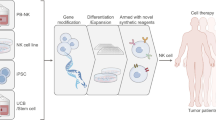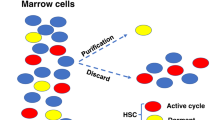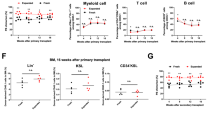Abstract
This protocol details a method for obtaining a considerable number of human mast cells from peripheral blood cells from normal donors without using stem cell mobilization treatment. By using the magnetic cell sorting system, 104–105 cells are retrieved in the CD34+ fraction when 100 ml of blood is drawn from a healthy donor. When these cells are cultured using methylcellulose medium supplemented with stem cell factor and interleukin 6, 103–104 mast cell colonies are formed in 6 weeks. The total mast cell number at 6 weeks of culture will be 106–107.
This is a preview of subscription content, access via your institution
Access options
Subscribe to this journal
Receive 12 print issues and online access
$259.00 per year
only $21.58 per issue
Buy this article
- Purchase on Springer Link
- Instant access to full article PDF
Prices may be subject to local taxes which are calculated during checkout



Similar content being viewed by others
References
Hawrylowicz, C.M., MacGlashan, D.W., Saito, H., Simon, H.-U. & Wardlaw, A.J. Effector cells of allergy. in Allergy 3rd edn. (eds. Church, M.K., Holgate, S.T. & Lichtenstein, L.W.) 351–373 (Mosby-Elsevier, London, UK, 2006).
Saito, H. et al. Selective differentiation and proliferation of hematopoietic cells induced by recombinant human interleukins. Proc. Natl. Acad. Sci. USA 85, 2288–2292 (1988).
Yang, Y.C. et al. Human IL-3 (multi-CSF): identification by expression cloning of a novel hematopoietic growth factor related to murine IL-3. Cell 47, 3–10 (1986).
Kitamura, T. & Miyajima, A. Functional reconstitution of the human interleukin-3 receptor. Blood 80, 84–90 (1992).
Okayama, Y. et al. Inhibition profiles of sodium cromoglycate and nedocromil sodium on mediator release from mast cells of human skin, lung, tonsil, adenoid and intestine. Clin. Exp. Allergy 22, 401–409 (1992).
Saito, H. et al. Selective growth of human mast cells induced by Steel factor, IL-6, and prostaglandin E2 from cord blood mononuclear cells. J. Immunol. 157, 343–350 (1996).
Nomura, I. et al. Human mast cell progenitors in peripheral blood from atopic subjects with high IgE levels. Clin. Exp. Allergy 31, 1424–1431 (2001).
Schwinger, W., Mache, C., Urban, C., Beaufort, F. & Toglhofer, W. Single dose of filgrastim (rhG-CSF) increases the number of hematopoietic progenitors in the peripheral blood of adult volunteers. Bone Marrow Transplant. 11, 489–492 (1993).
Kirshenbaum, A.S. et al. Demonstration that human mast cells arise from a progenitor cell population that is CD34+, c-kit+, and expresses aminopeptidase N (CD13). Blood 94, 2333–2342 (1999).
Saito, H. et al. Human mast cell colony-forming cells in culture. Int. Arch. Allergy Immunol. 124, 301–303 (2001).
Dahl, C., Saito, H., Nielsen, H.V. & Schiotz, P.O. The establishment of a combined serum-free and serum-supplemented culture method of obtaining functional cord blood-derived human mast cells. J. Immunol. Methods 262, 137–143 (2002).
Iida, M. et al. Selective down-regulation of high-affinity IgE receptor (FcεRI) α-chain messenger RNA among transcriptome in cord blood-derived versus adult peripheral blood-derived cultured human mast cells. Blood 97, 1016–1022 (2001).
Nomura, I. et al. Human mast cell progenitors in peripheral blood from atopic subjects with high IgE levels. Clin. Exp. Allergy 31, 1424–1431 (2001).
Nakajima, T. et al. Identification of granulocyte subtype-selective receptors and ion channels by using a high-density oligonucleotide probe array. J. Allergy Clin. Immunol. 113, 528–535 (2004).
Acknowledgements
We thank Mr. Takahisa Ogasawara and Mr. Keisuke Yuki for their help with the experimental details. This work was supported by Grant ID05-24 from the National Institute of Biomedical Innovation.
Author information
Authors and Affiliations
Corresponding author
Ethics declarations
Competing interests
The authors declare no competing financial interests.
Supplementary information
Supplementary Table 1
The normalized AD levels of 22,283 kinds of transcripts expressed by CD34+-derived cells on days 0, 3, 5, 42 and 77 are shown (XLS 5588 kb)
Supplementary Information
Supplemental Information on GeneChip expression analysis [embedded in word doc] (PDF 69 kb)
Rights and permissions
About this article
Cite this article
Saito, H., Kato, A., Matsumoto, K. et al. Culture of human mast cells from peripheral blood progenitors. Nat Protoc 1, 2178–2183 (2006). https://doi.org/10.1038/nprot.2006.344
Published:
Issue Date:
DOI: https://doi.org/10.1038/nprot.2006.344
This article is cited by
-
Discovery of an agonistic Siglec-6 antibody that inhibits and reduces human mast cells
Communications Biology (2022)
-
A monoclonal antibody to Siglec-8 suppresses non-allergic airway inflammation and inhibits IgE-independent mast cell activation
Mucosal Immunology (2021)
-
Rapid identification of human mast cell degranulation regulators using functional genomics coupled to high-resolution confocal microscopy
Nature Protocols (2020)
-
Novel six-week protocol for generating functional human connective tissue-type (MCTC) mast cells from buffy coats
Inflammation Research (2017)
-
An immunoglobulin-like receptor, Allergin-1, inhibits immunoglobulin E–mediated immediate hypersensitivity reactions
Nature Immunology (2010)
Comments
By submitting a comment you agree to abide by our Terms and Community Guidelines. If you find something abusive or that does not comply with our terms or guidelines please flag it as inappropriate.



